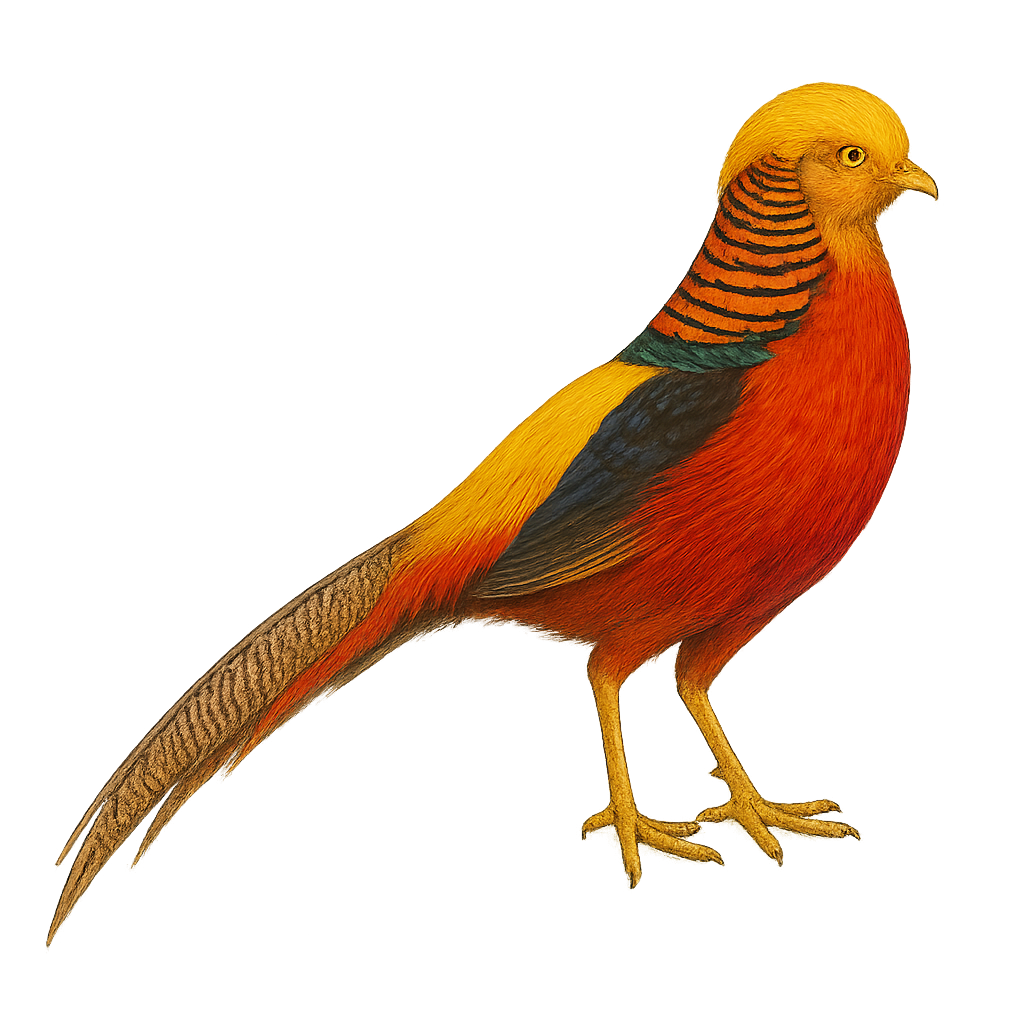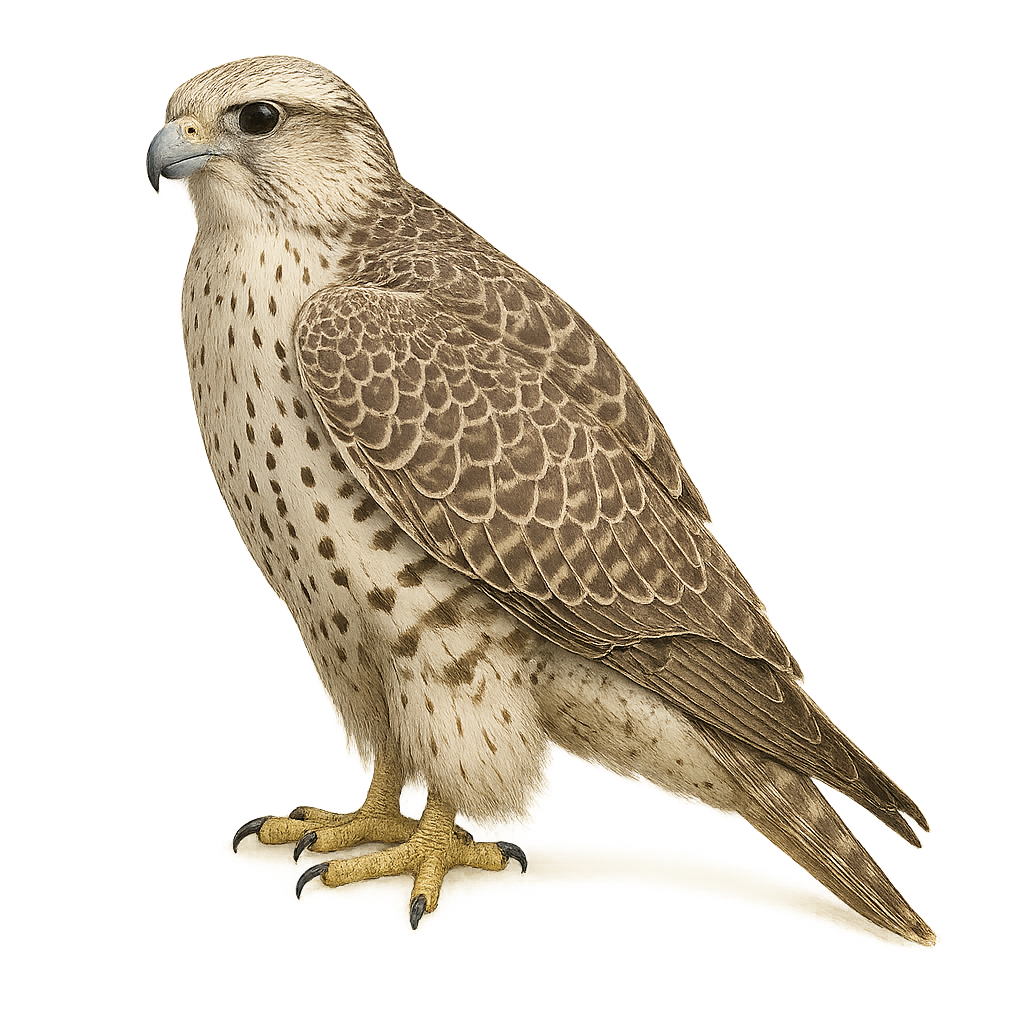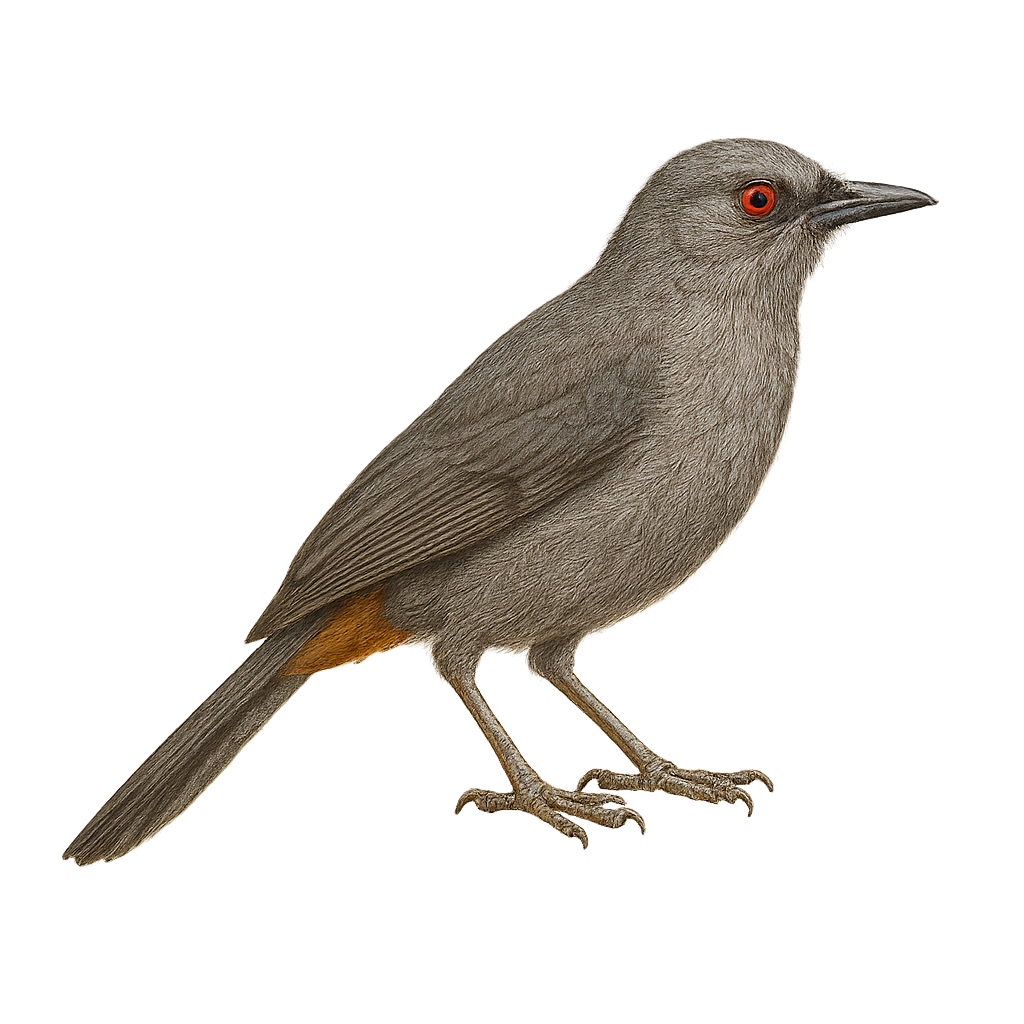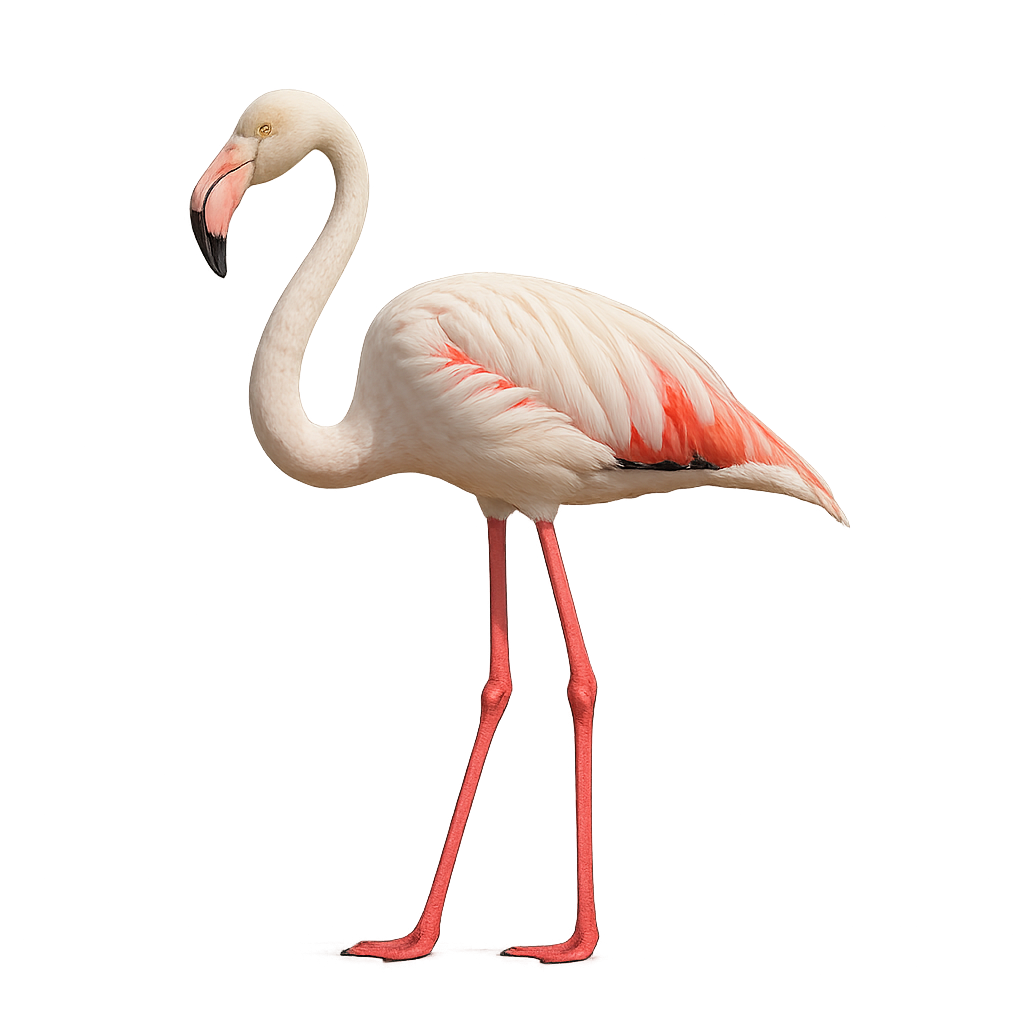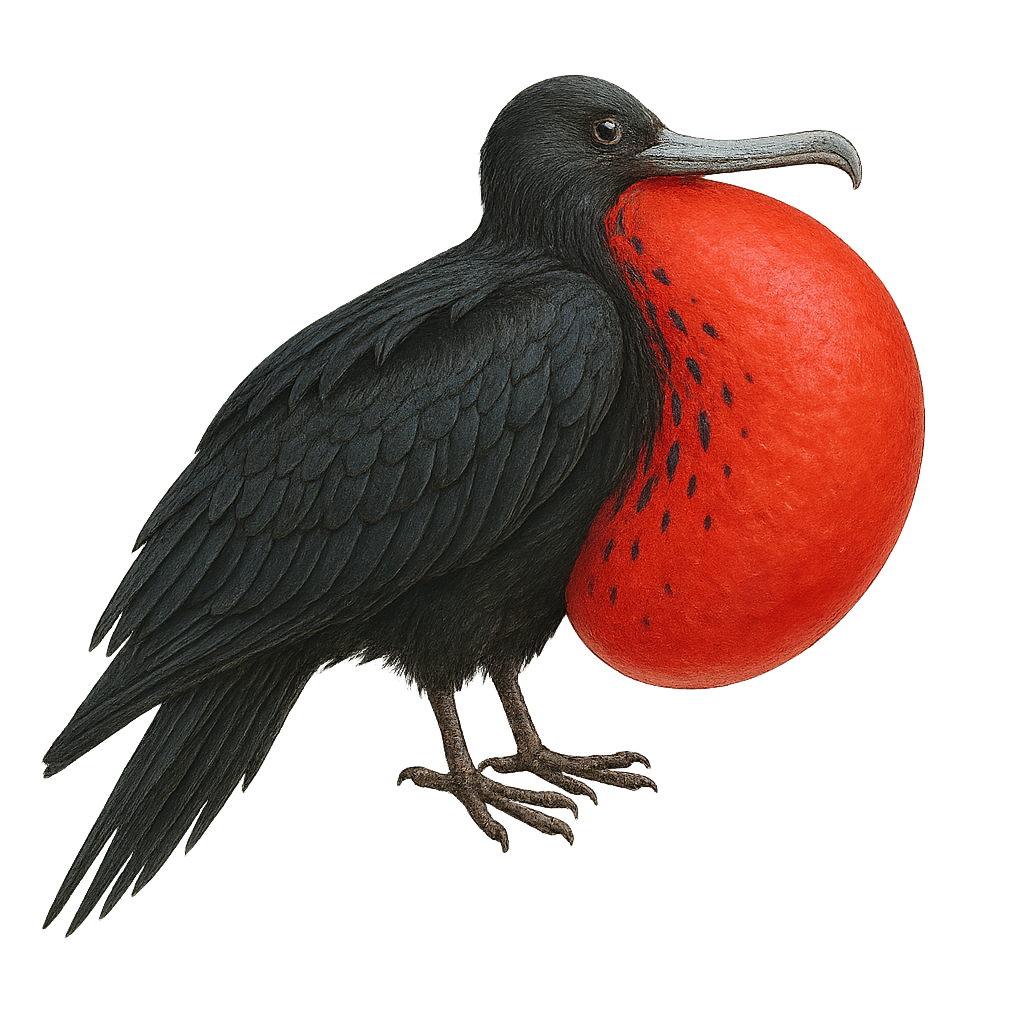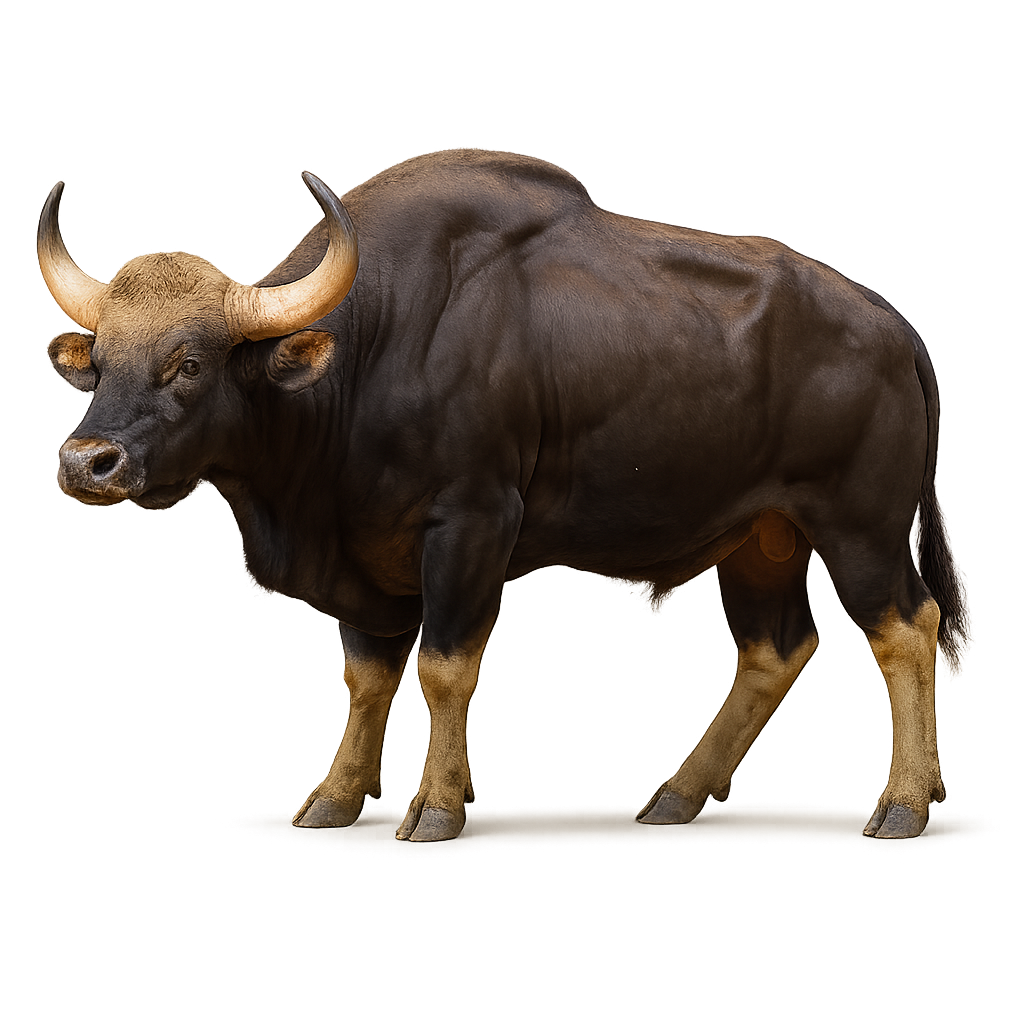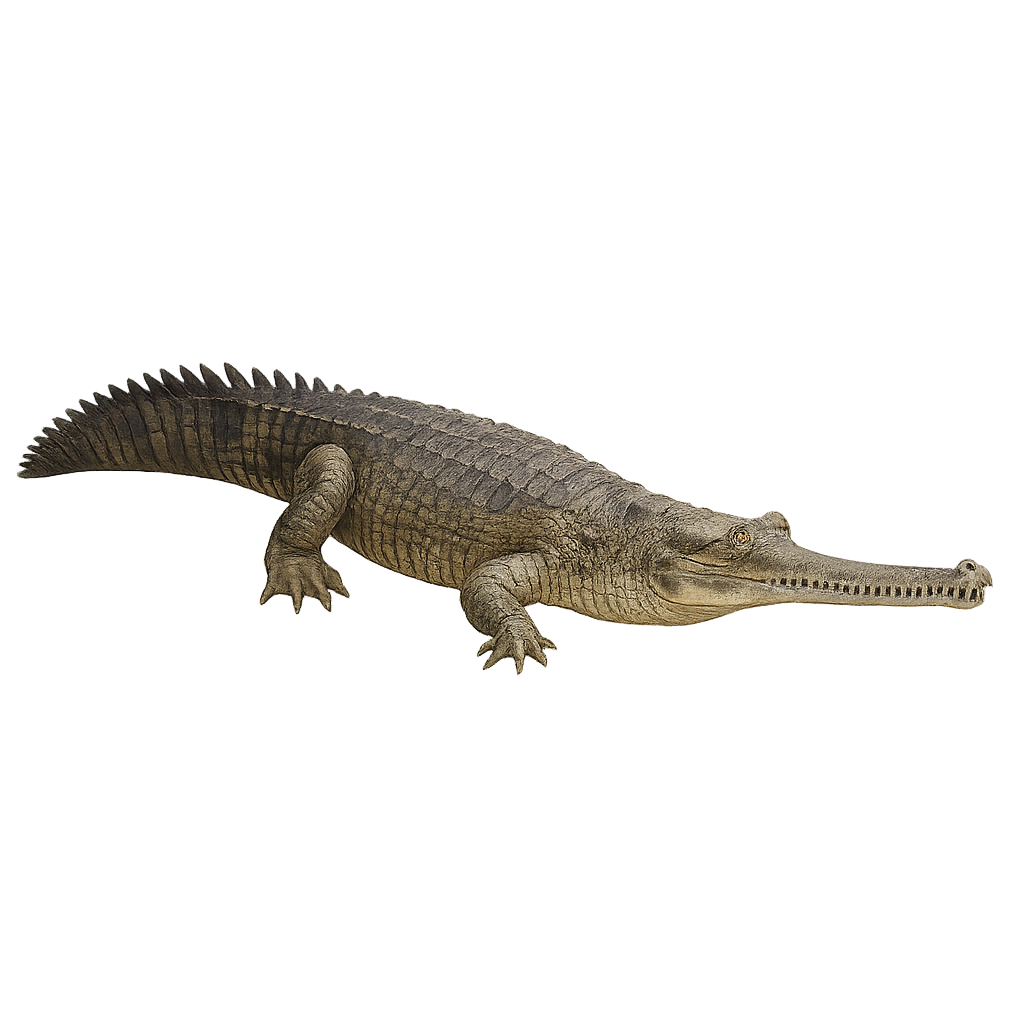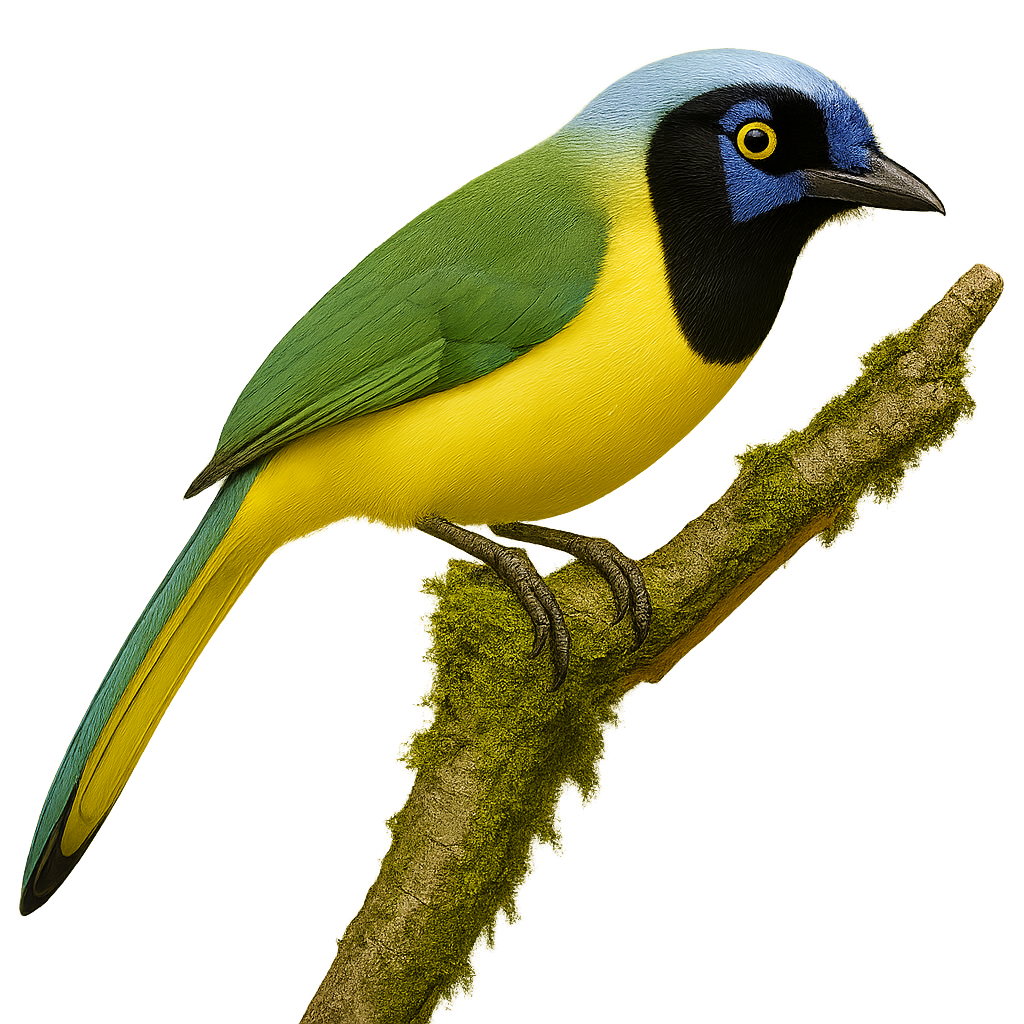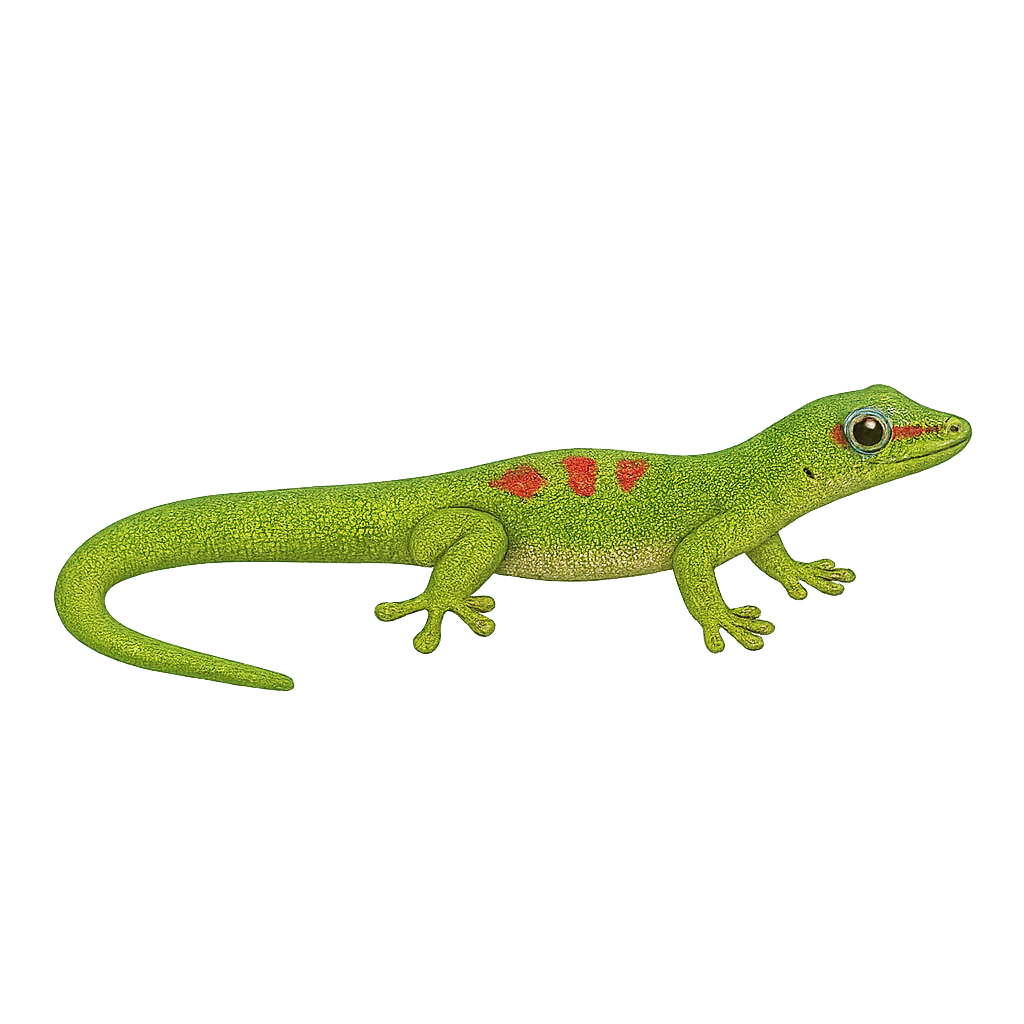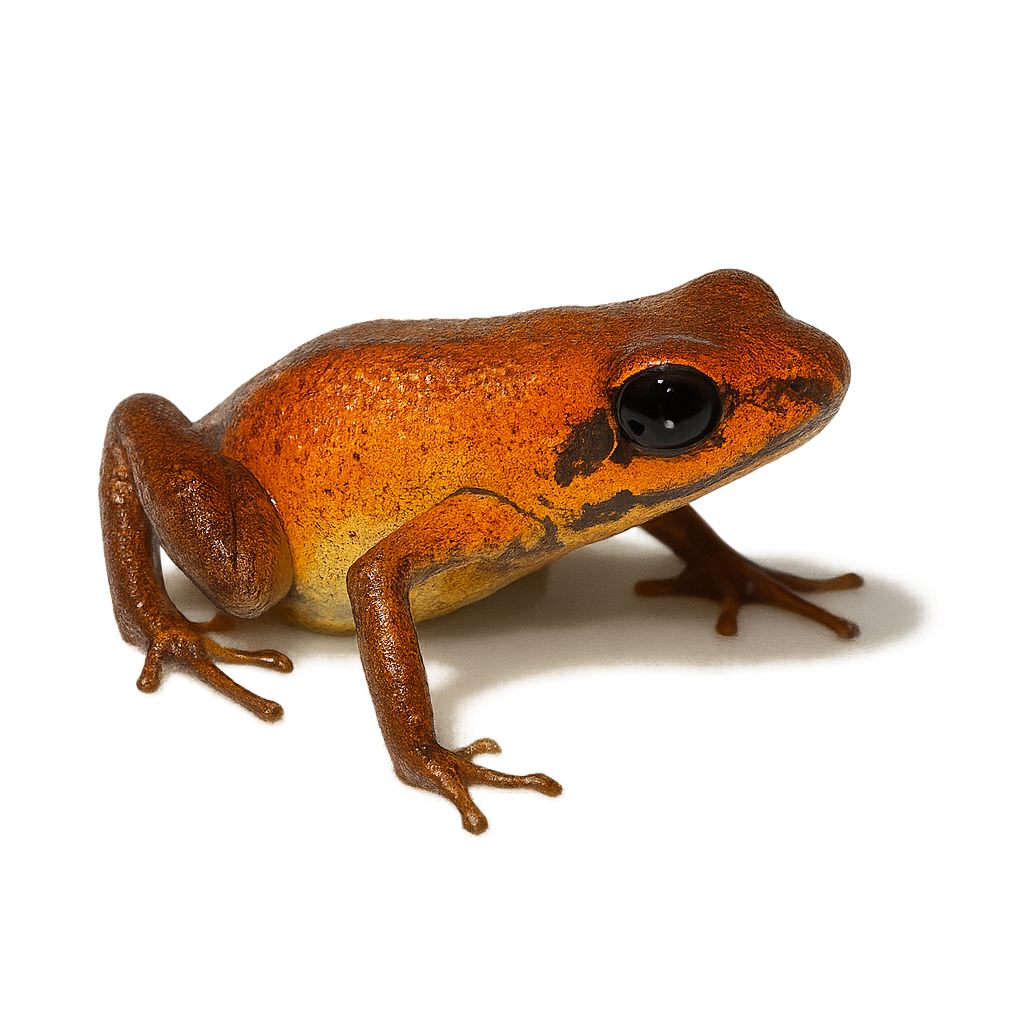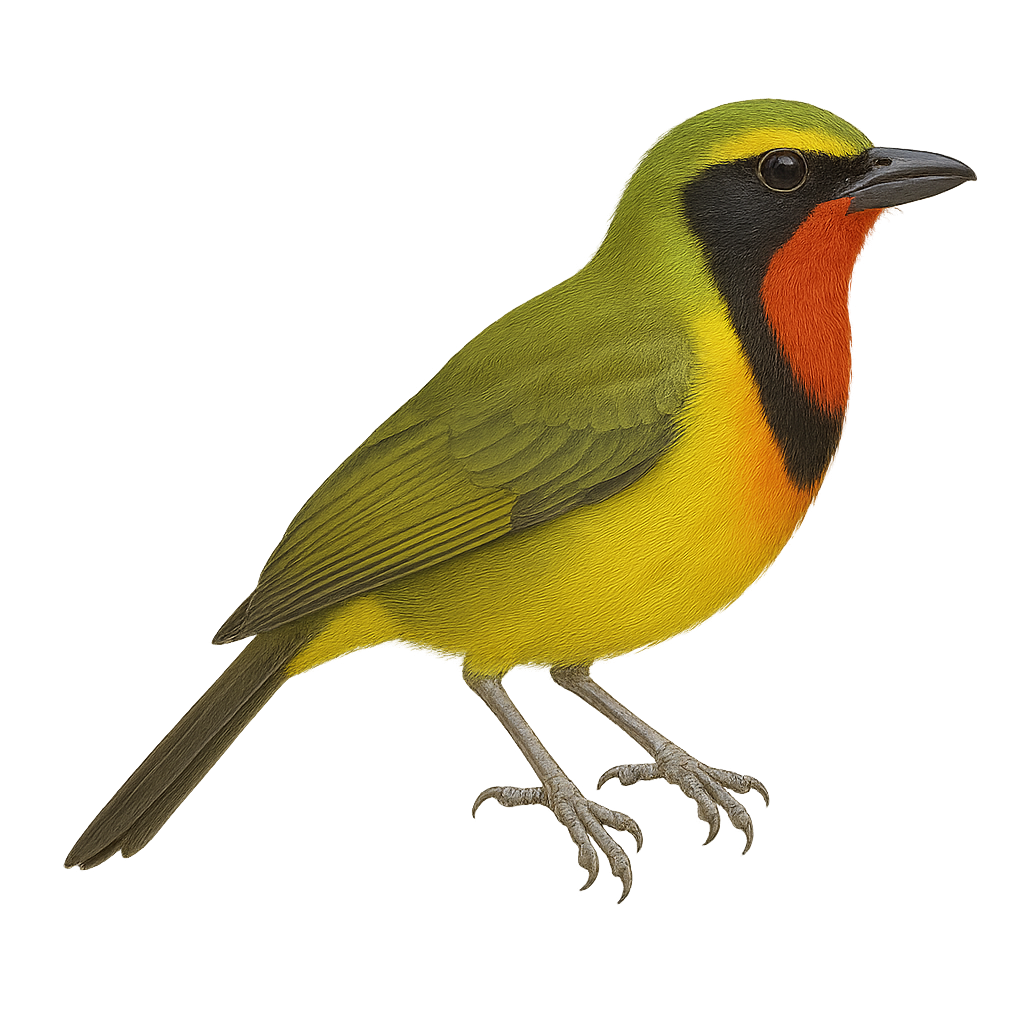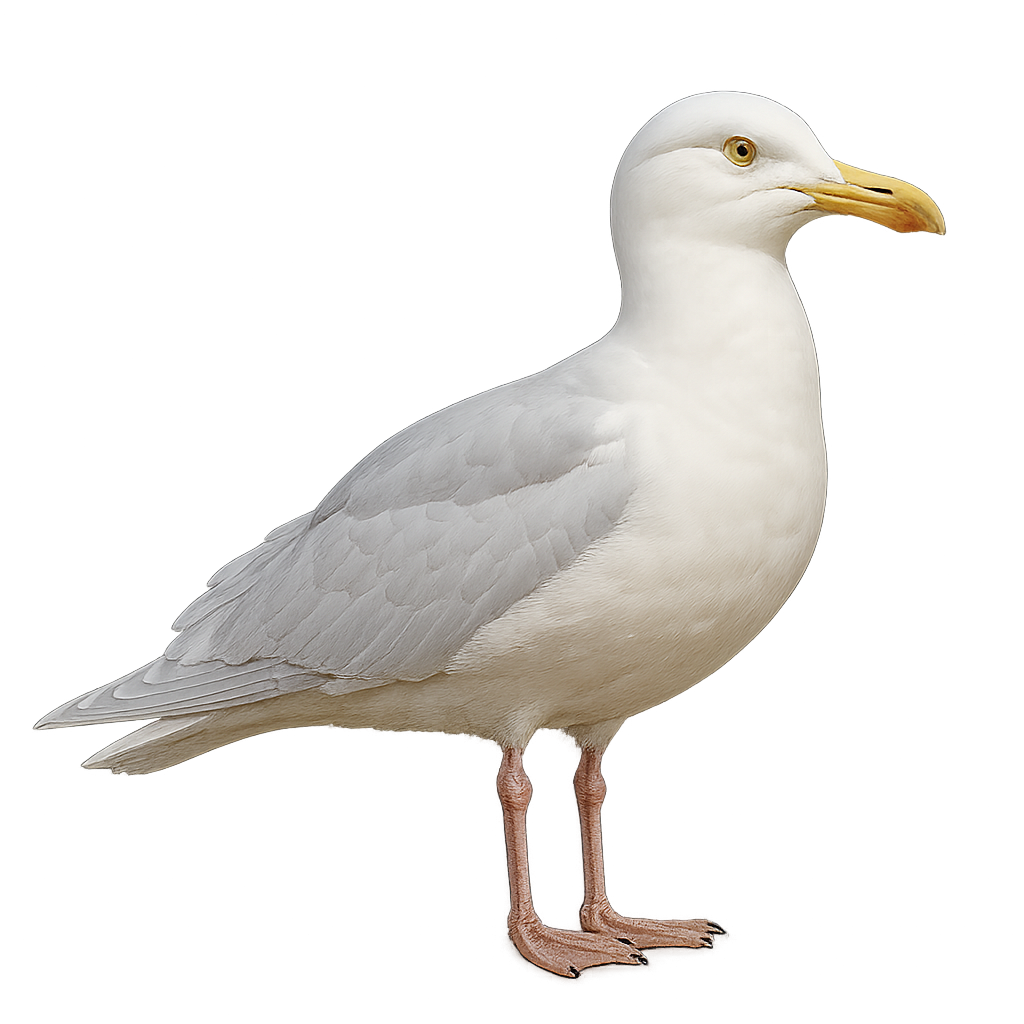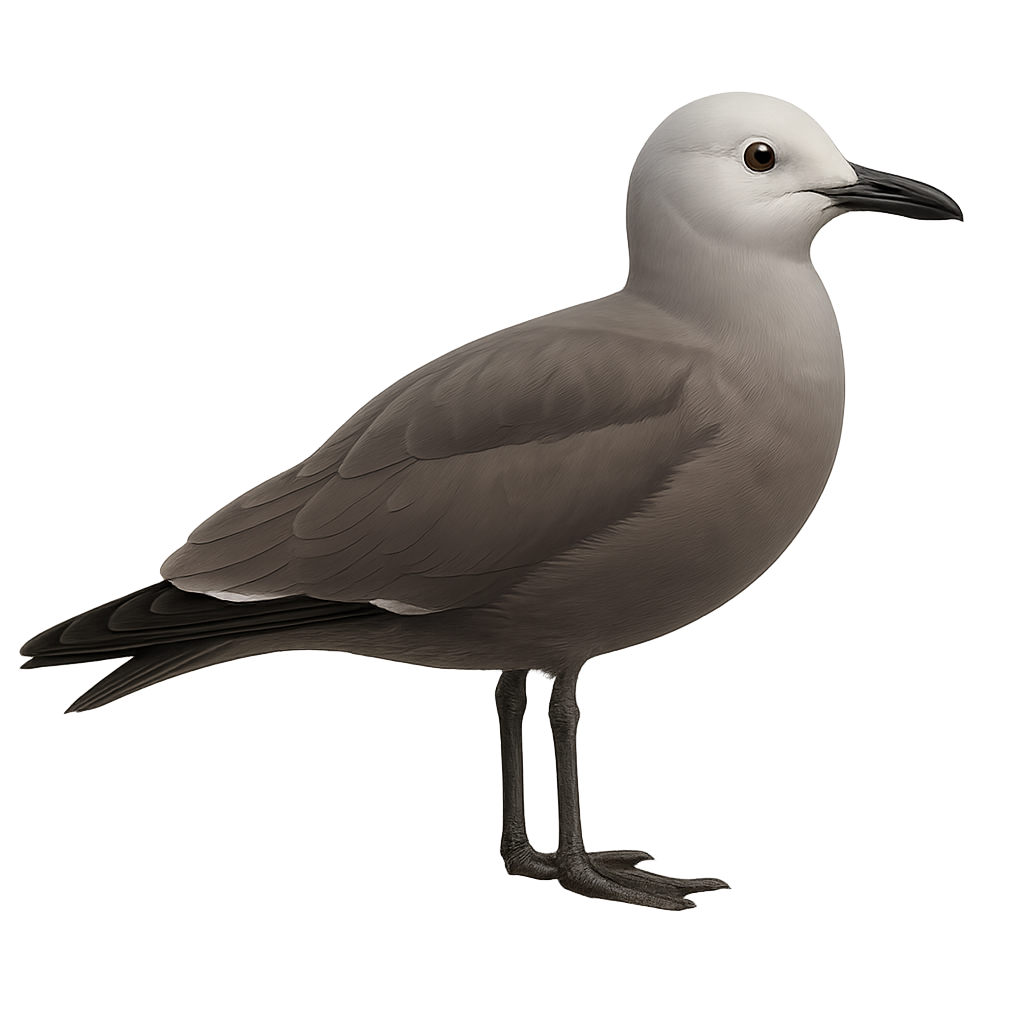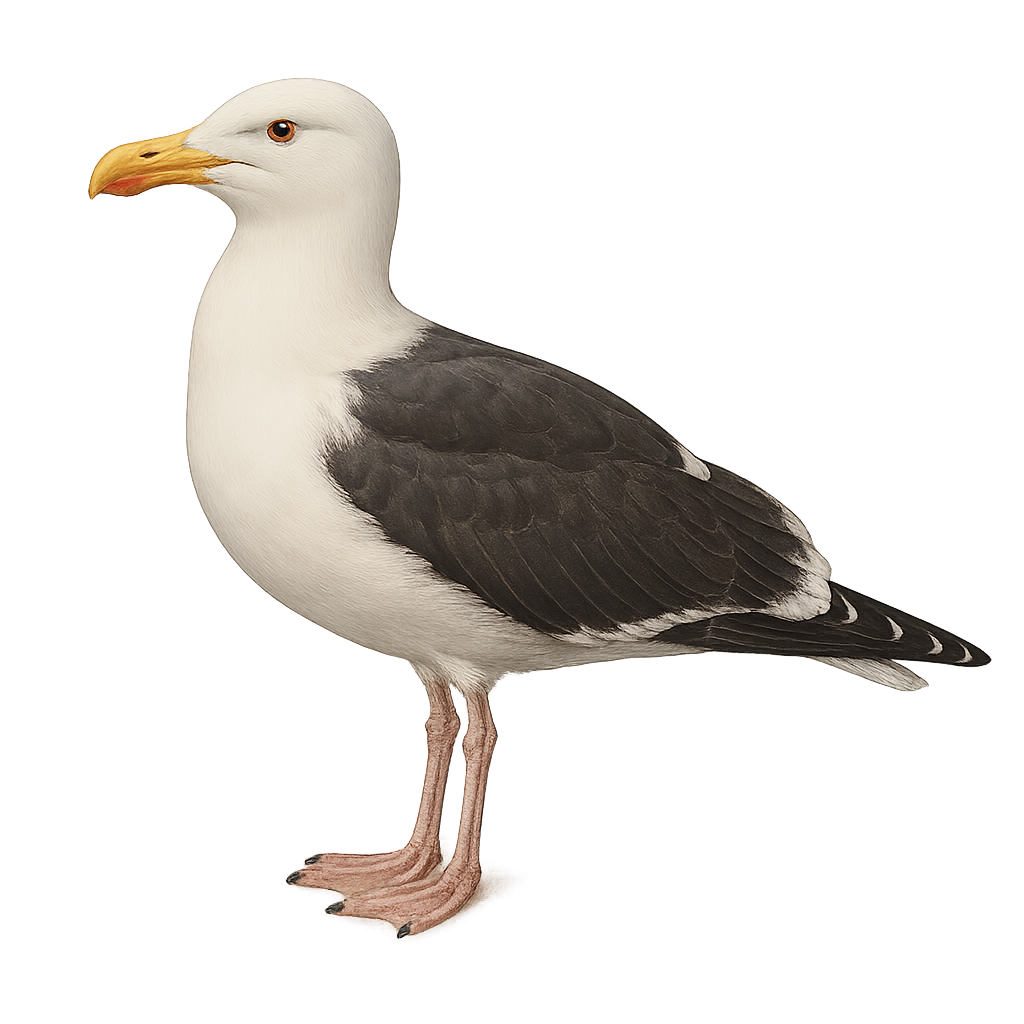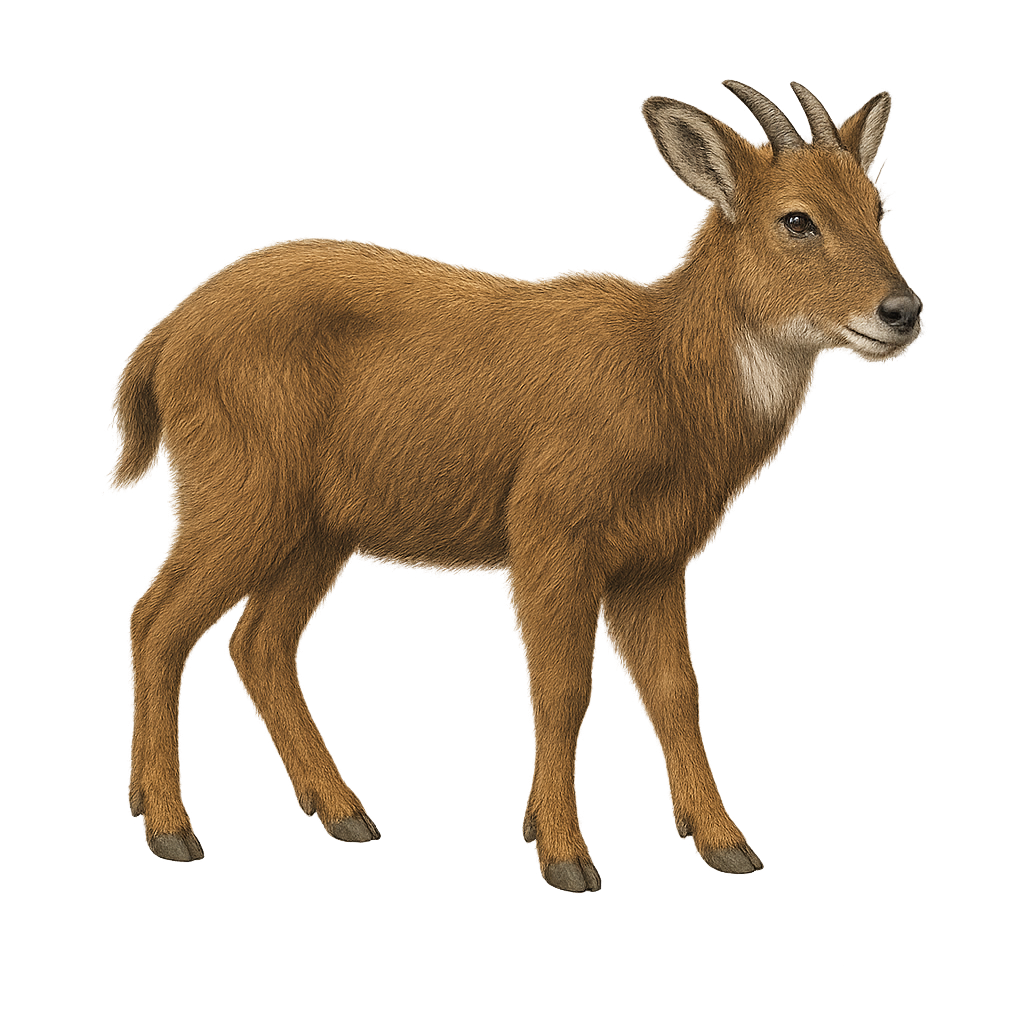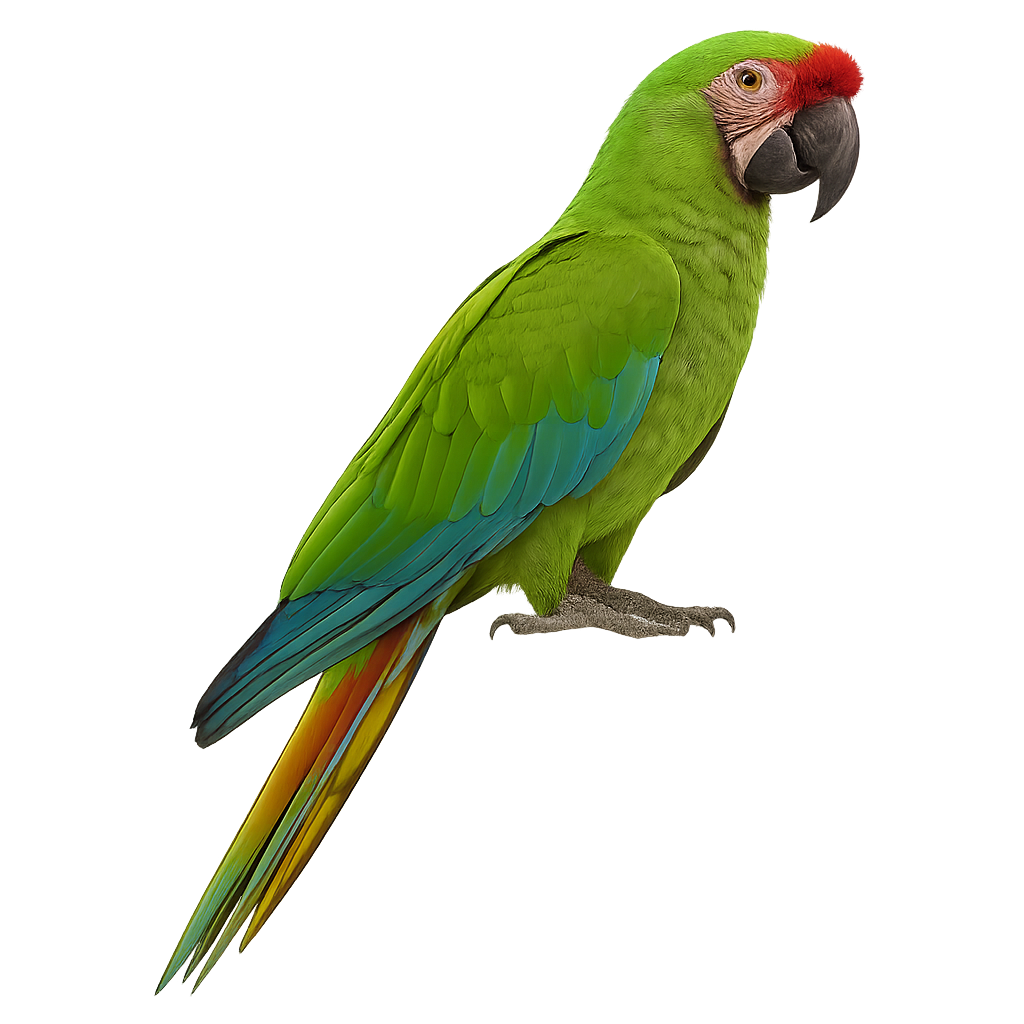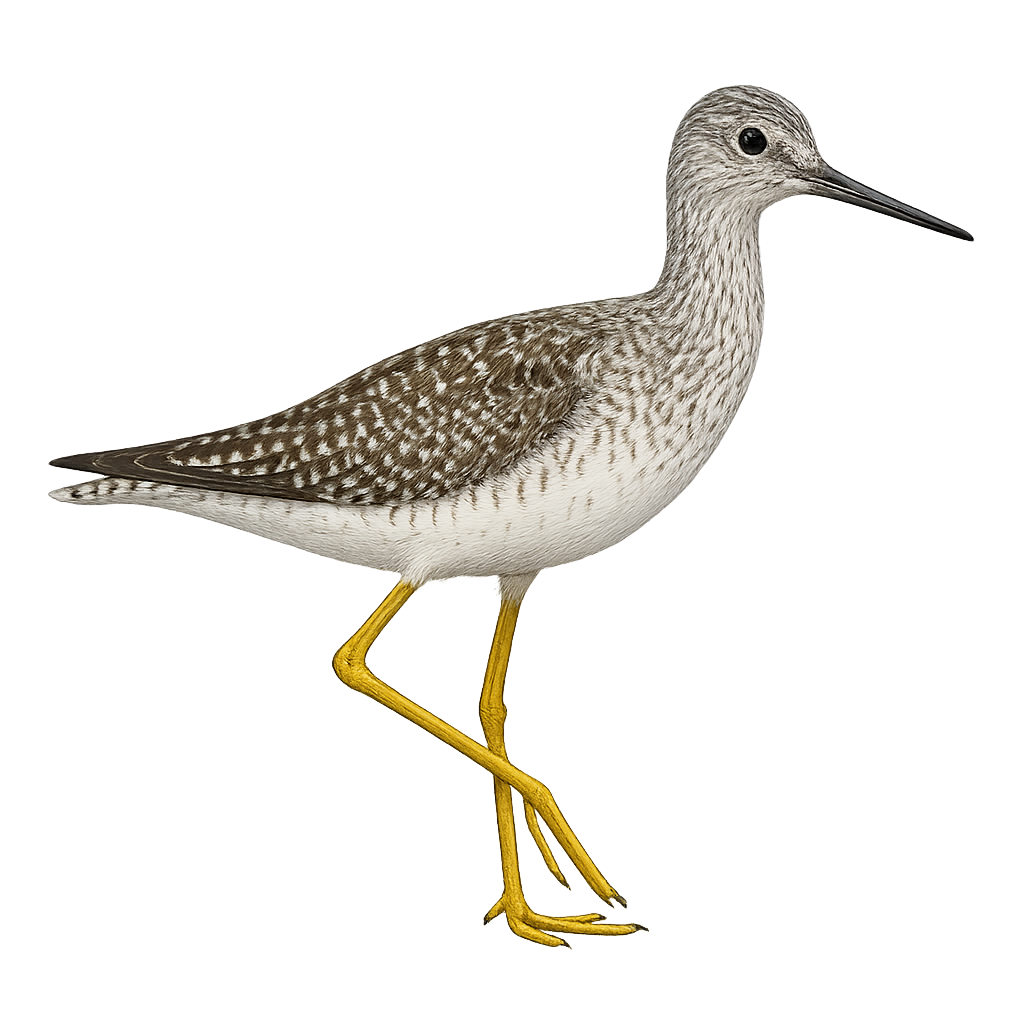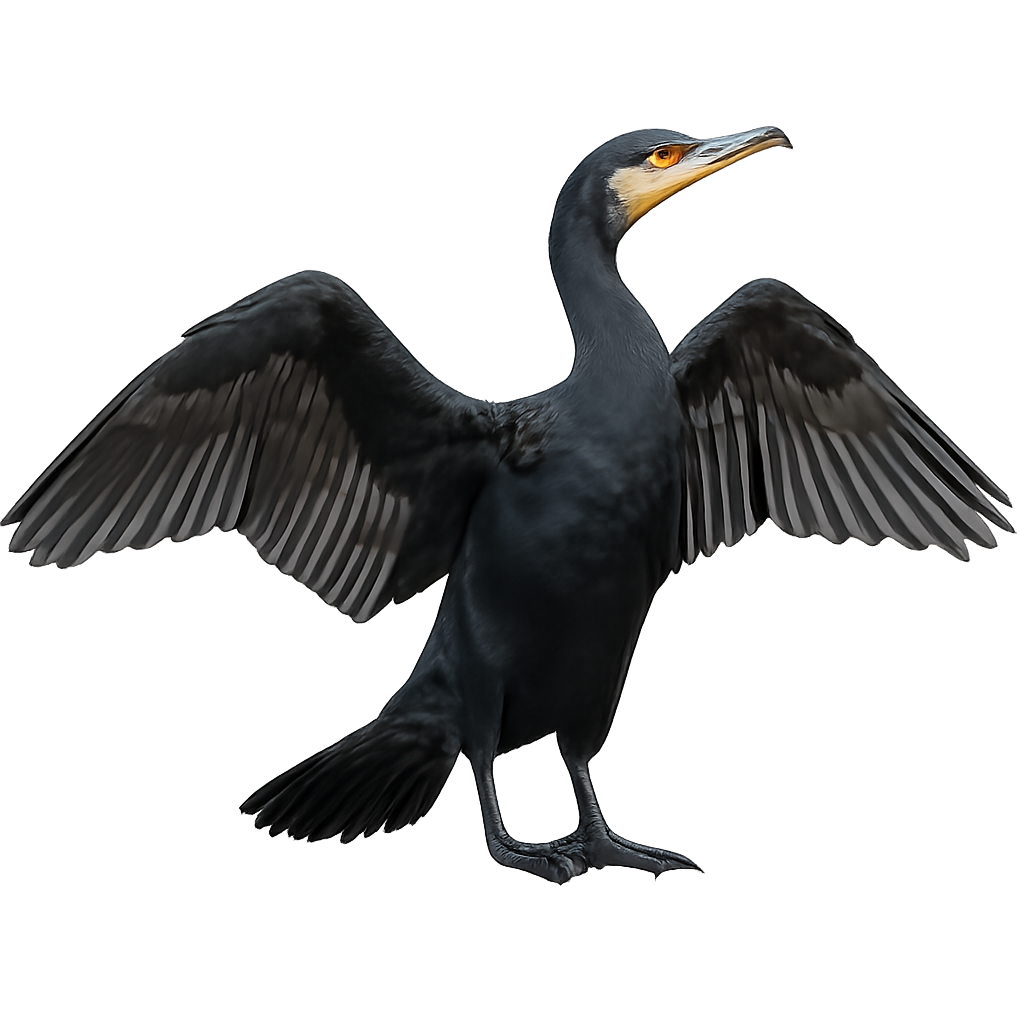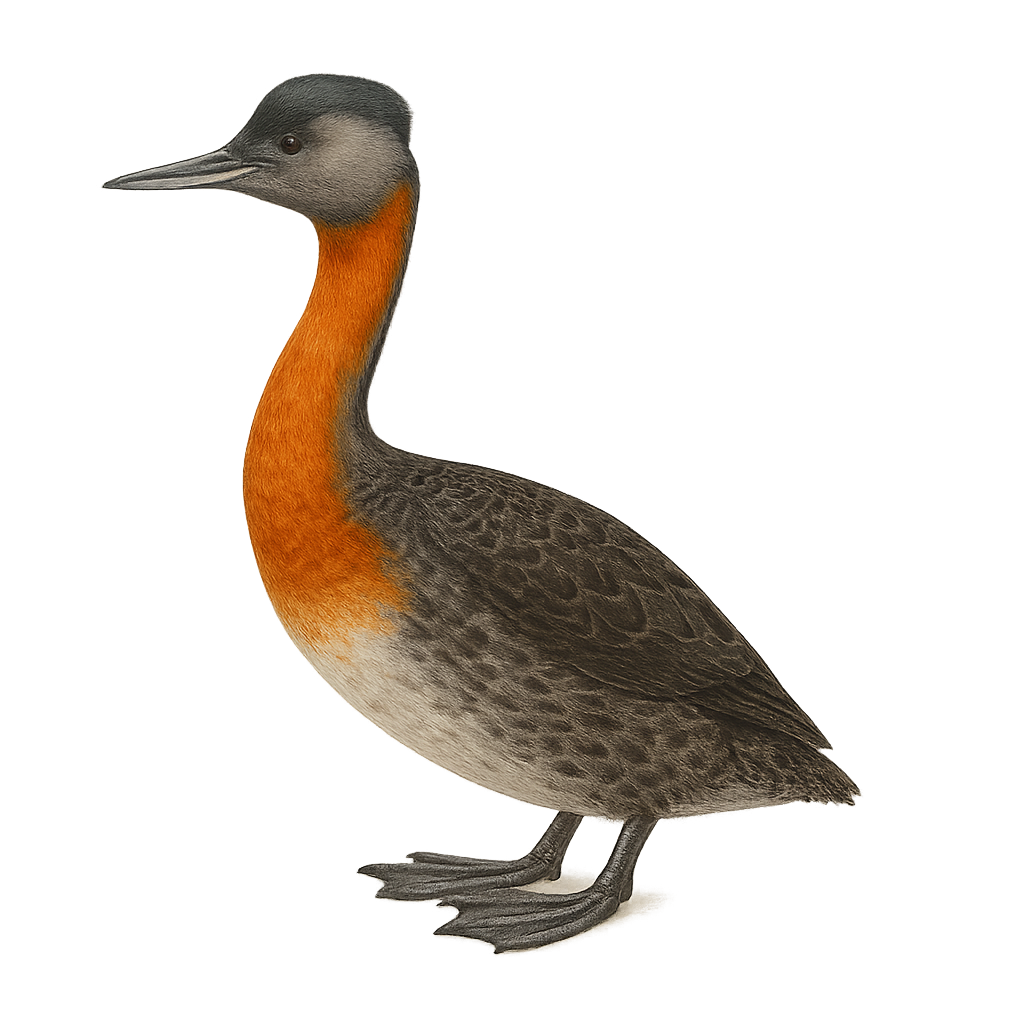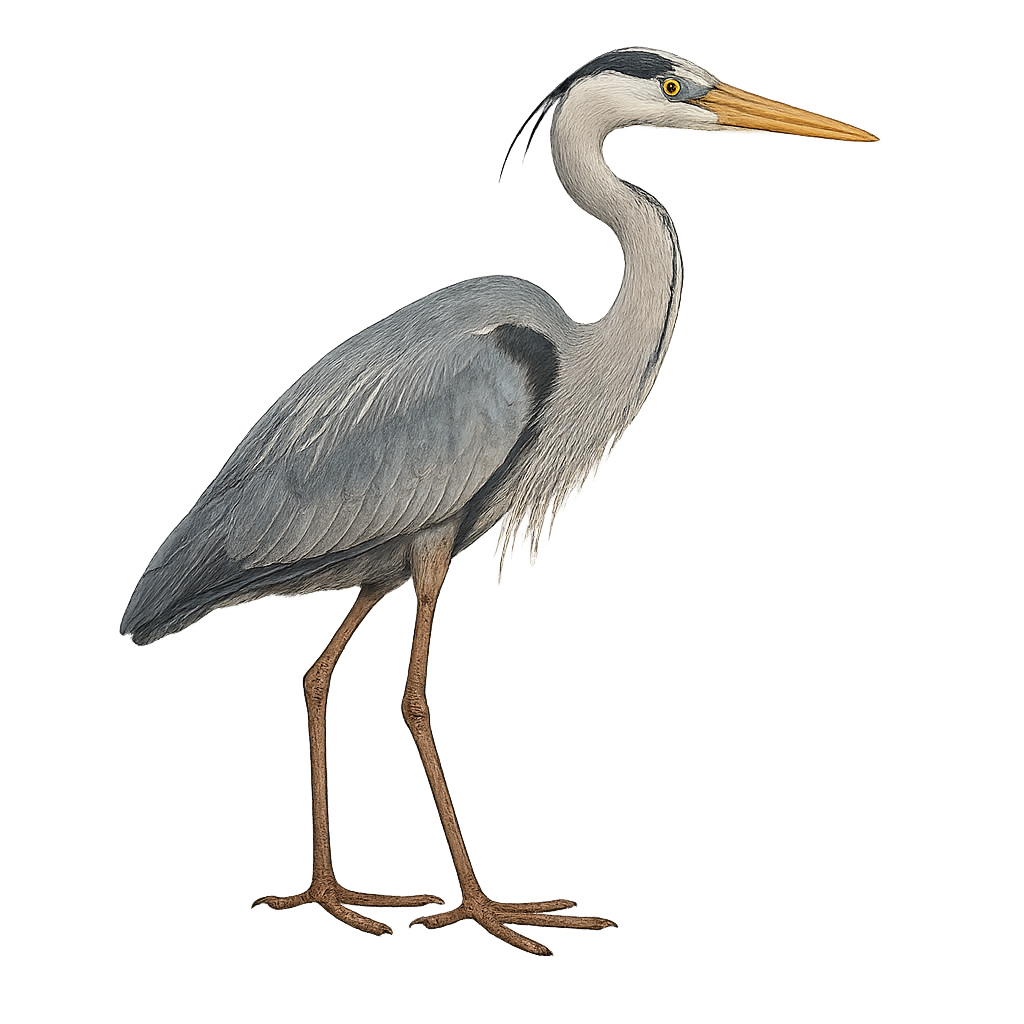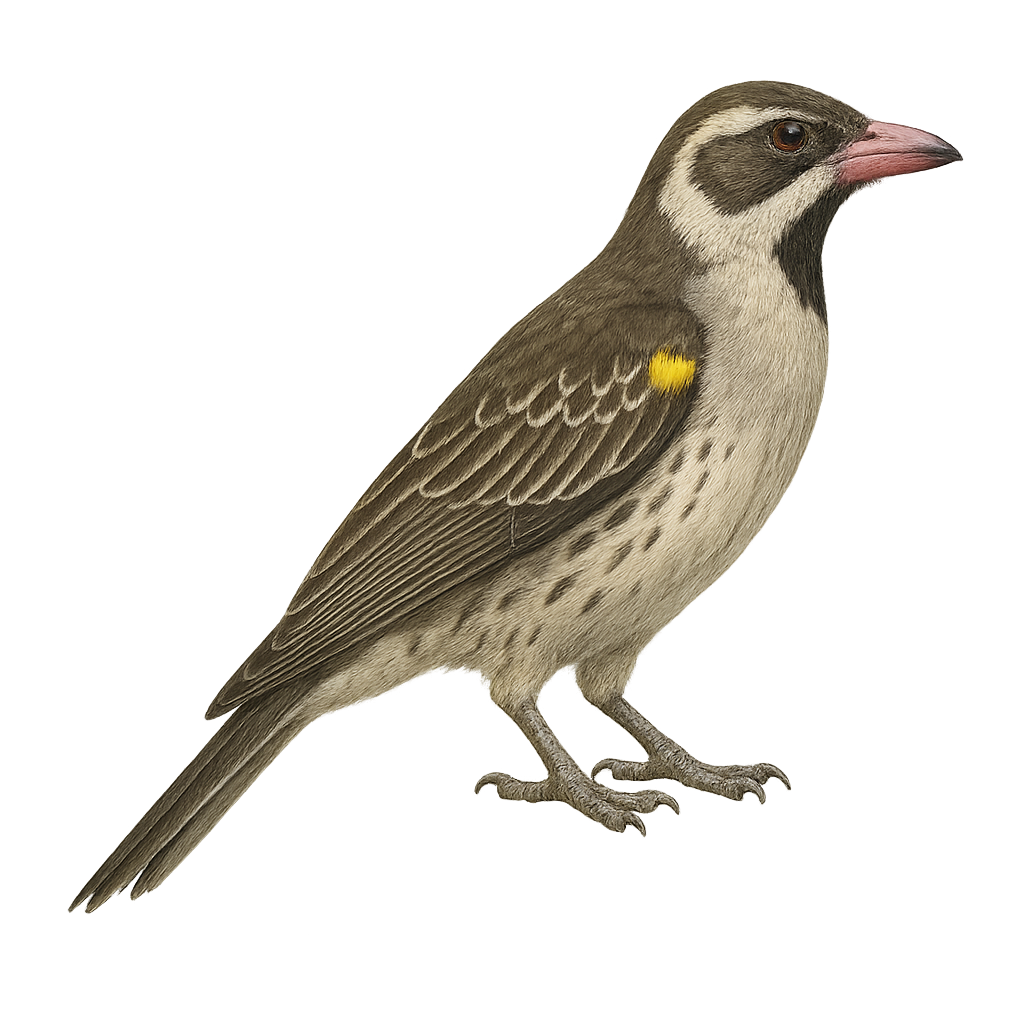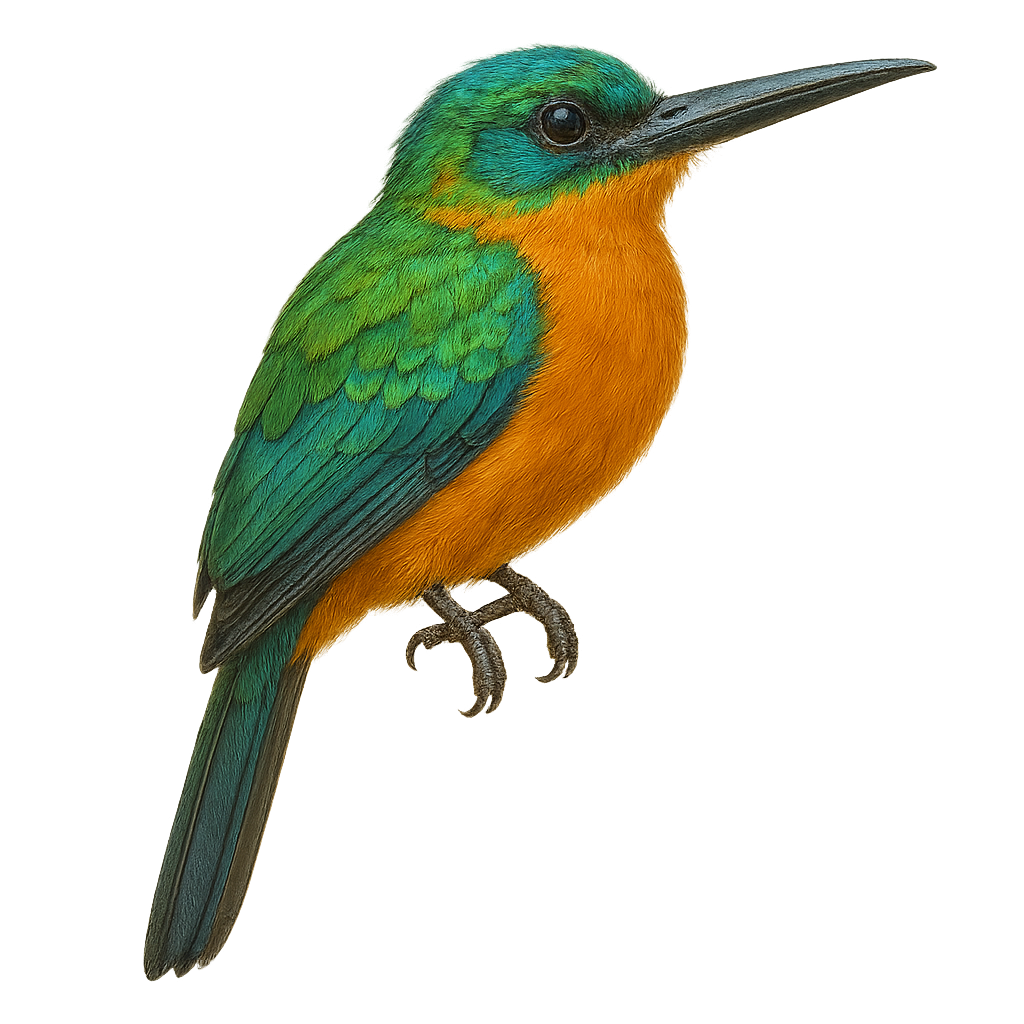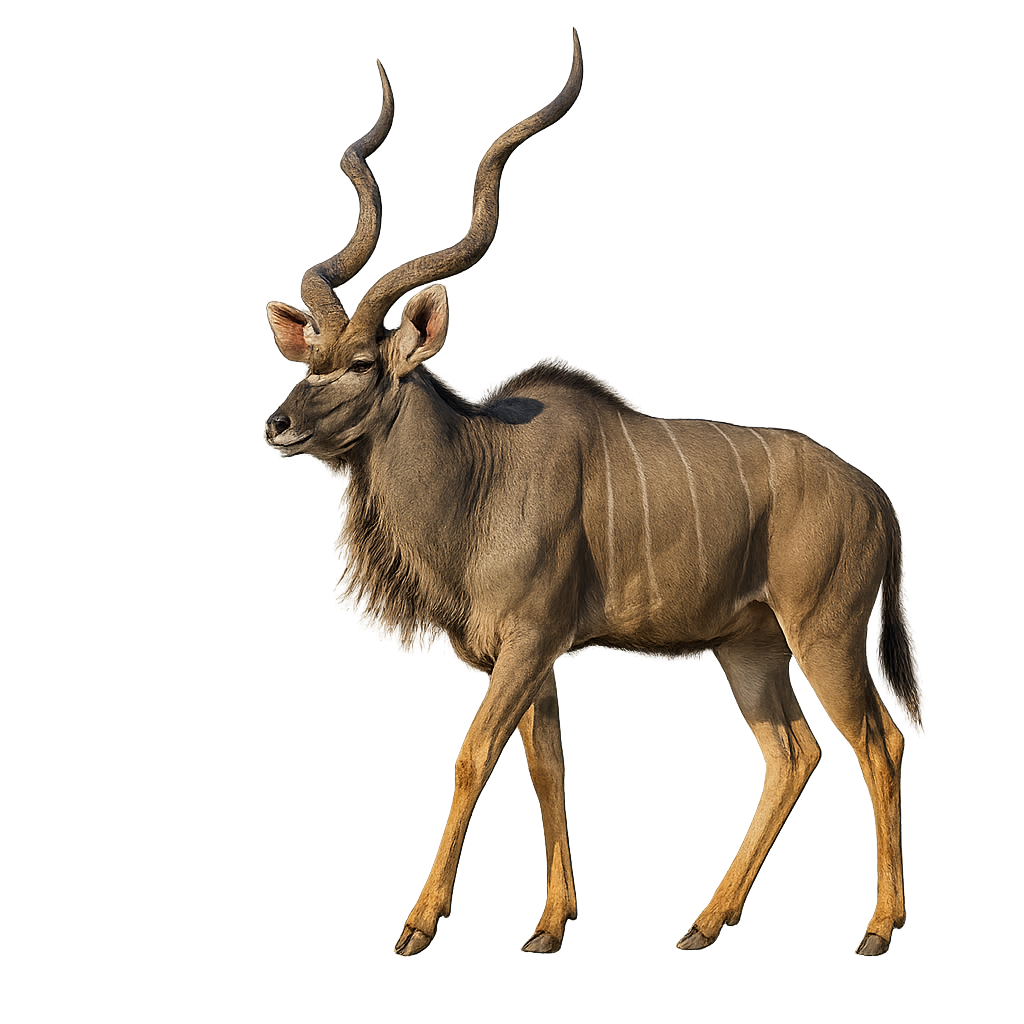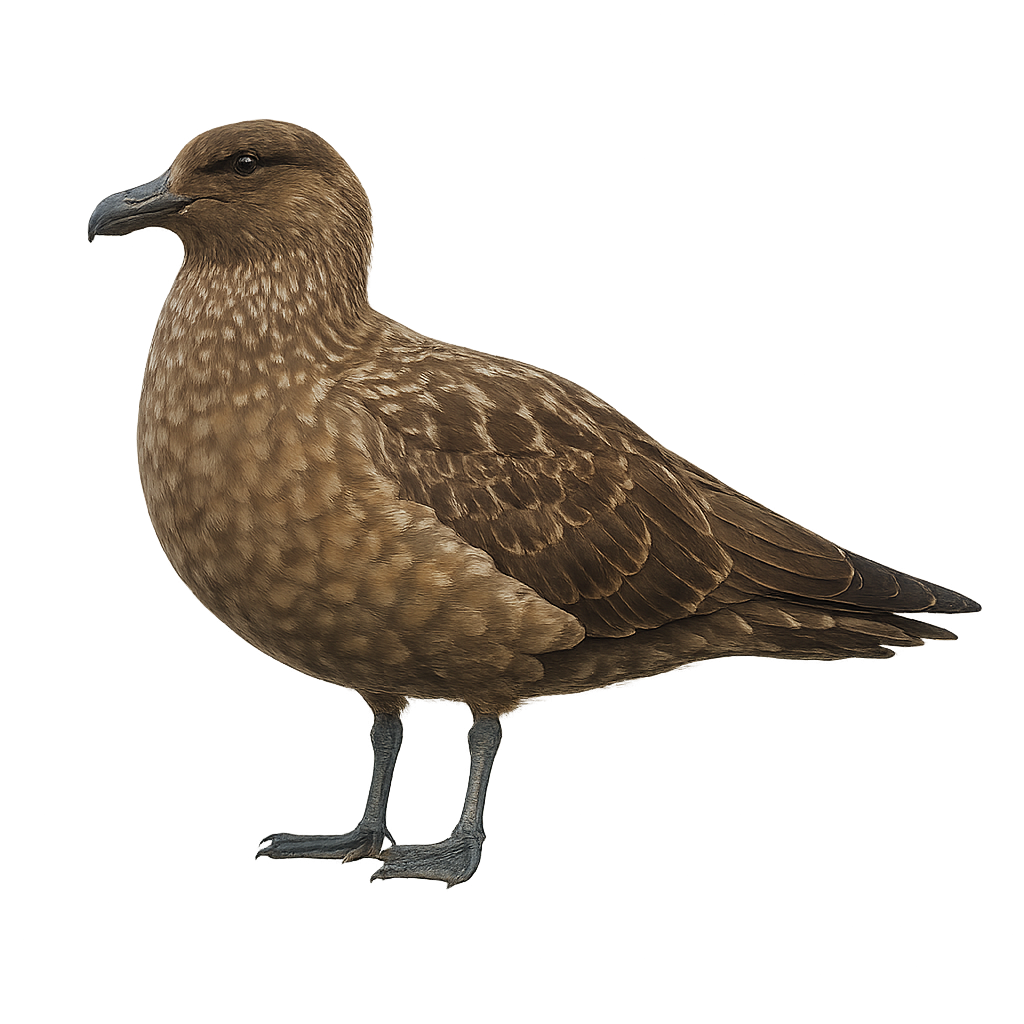The Golden Pheasant, Chrysolophus pictus, is a stunning bird native to the mountainous forests of China. It is renowned for its vibrant plumage, particularly the male, which displays bright colors such as red, yellow, and blue. Its head is adorned with a golden crest that extends into a golden mantle on its back. Females, on the other hand, are more subdued with brown mottled plumage that allows them to blend into their natural habitat. These birds are primarily terrestrial, feeding on seeds, berries, and insects. Although they are capable of flight, they prefer to run to escape predators.
The gyrfalcon, or Falco rusticolus, is the largest of the falcons, known for its robustness and ability to survive in harsh Arctic environments. Its impressive size, with a wingspan reaching up to 160 cm, and its variable plumage ranging from pure white to dark grey, make it a spectacular bird. It is primarily found in circumpolar regions, nesting on cliffs and isolated mountains. A formidable predator, it mainly hunts medium-sized birds such as ptarmigans and ducks. The gyrfalcon is a symbol of power and majesty in many Nordic cultures. Its population is stable, although locally threatened by climate change and human disturbance.
The Galinier's Turaco is a fascinating bird, endemic to the mountainous forests of Ethiopia. With its bright green plumage and distinctive crest, it is easily recognizable. This bird measures about 40 cm in length and primarily feeds on fruits, but it can also consume leaves and flowers. It is often observed in small groups, moving agilely through the canopy. Although its habitat is limited, it adapts well to high-altitude forests, allowing it to survive despite increasing human pressure. Its presence is an indicator of the health of the region's forest ecosystems.
The garden warbler is a small passerine bird found primarily in hedgerows, gardens, and bushes across Europe and Asia. It is easily recognized by its grey-olive plumage, light belly, and keen eyes. This small bird is especially known for its powerful and melodious song, which it performs during the breeding season. It primarily feeds on insects and berries, which it finds in bushes and trees.
The Greater Flamingo is a large bird with distinctive plumage, easily recognizable by its vivid colors and graceful silhouette. It stands about 1.4 to 1.7 meters tall and weighs between 2.5 and 4 kg. Its plumage is primarily pale pink, with more intense shades on the wings, and its long legs and neck give it a majestic posture. The Flamingo's beak is curved downward, allowing it to filter water and feed primarily on plankton, small shrimp, and algae. This bird primarily inhabits wetlands, saline lagoons, and salt marshes, where it often gathers in large colonies. Flamingos feed by dipping their heads into the water while walking in shallow waters, using their beaks to filter food. While the species is not threatened, it faces risks related to habitat loss, pollution, and human disturbance.
The Great Frigatebird, or Fregata minor, is an impressive seabird known for its large size and wingspan, which can reach up to 2.3 meters. This large black bird is easily recognizable by its slender silhouette and hooked beak. Males display a bright red gular pouch that they inflate to attract females. Frigatebirds are masters of flight, capable of staying aloft for several days thanks to their long, slender wings. They primarily feed on fish and squid, which they catch in flight or by harassing other birds to steal their prey. They are mainly found in the tropical and subtropical regions of the Pacific and Indian Oceans.
The Gaur is a large bovine, considered one of the most impressive species of wild cattle. It stands between 1.8 and 2 meters at the withers and can weigh from 500 to 1,000 kg, with males generally being larger and heavier than females. Its coat is dark, typically black or dark brown, with light markings on the legs and a distinctive mane around the neck. The Gaur primarily inhabits dense forests and mountains in South and Southeast Asia, especially in India, Nepal, Indonesia, and Malaysia. Herbivorous, it primarily feeds on grasses, young shoots, leaves, and fruits. The Gaur is a social animal, living in groups, although it is often observed alone or in small groups while foraging. Due to hunting, habitat loss, and conflicts with human populations, the Gaur is listed as vulnerable by the International Union for Conservation of Nature (IUCN).
The Ganges gavial is a distinctive crocodilian, easily recognized by its long, narrow snout that allows it to capture fish in the rivers of the Indian subcontinent. This aquatic reptile is primarily found in the rivers of the Ganges and its tributaries in India and Nepal. The Ganges gavial is an excellent swimmer and feeds almost exclusively on fish, which it captures using its long, slender snout like a pincer. Although relatively calm, it is listed as endangered due to habitat loss and river pollution. It is currently protected by conservation programs.
The goitered gazelle, or Gazella subgutturosa, is a species of gazelle known for its enlarged neck, particularly in males. It primarily inhabits the steppes and deserts of Central Asia and the Middle East. This gazelle is well adapted to arid environments and can survive with minimal water, feeding on drought-resistant plants. It is known for its speed and agility, which help it evade natural predators. Males have lyre-shaped horns, while females have smaller horns or none at all. The goitered gazelle is a vulnerable species due to hunting and habitat loss.
The Grant's Gazelle is an elegant, medium-sized antelope, easily recognizable by its long legs and generally sandy-colored coat with distinctive markings. It stands about 75 cm at the withers and weighs between 40 and 60 kg. The coat of the Grant's Gazelle is primarily beige with darker vertical stripes along the flanks and a black stripe running across its back. Adult males have long, slightly curved horns in the shape of a lyre, while females generally lack them. This gazelle primarily inhabits savannas, grasslands, and wooded areas in East Africa, particularly in Kenya, Tanzania, and Uganda. Herbivorous, it primarily feeds on herbaceous plants, leaves, fruits, and bark. Very fast and agile, the Grant's Gazelle can reach speeds of up to 80 km/h, allowing it to escape many predators. Although the species is not endangered, it faces threats such as habitat loss, hunting, and competition with livestock for food resources.
The Green Jay, or Cyanocorax yncas, is a striking bird with vibrant plumage, primarily green with shades of blue and yellow. It inhabits the tropical and subtropical forests of Central and South America. This sociable bird lives in groups and is known for its intelligence and tool-using abilities. It primarily feeds on insects, fruits, and seeds. The Green Jay is also an excellent mimic of sounds, allowing it to communicate effectively with its peers. Its presence is often marked by its distinctive calls and agile flight through the dense canopy.
The Phelsuma laticauda, commonly known as the gold dust day gecko, is a small, brightly colored lizard native to Madagascar and nearby islands. It is easily recognizable by its vibrant green color, often adorned with golden or red spots on its back. Its size typically ranges from 10 to 15 cm, including the tail. This gecko is diurnal, meaning it is active during the day, and is often seen on tree trunks or the walls of human dwellings. It primarily feeds on insects but also enjoys nectar and fruits. Its ability to adapt to various environments, including urban areas, makes it a fascinating example of animal adaptation.
The Geminis’ dart frog, Andinobates geminisae, is a small, brightly colored frog native to the humid rainforests of Panama. Recently discovered, it is distinguished by its vivid orange color and small size, measuring about 1.5 cm. This species primarily inhabits leaf litter and moist forest areas, feeding on small invertebrates. Like other poison frogs, it is known for its toxic skin, a defense against predators. Reproduction involves laying eggs in moist spots, with notable parental care where adults transport tadpoles to water bodies. This species is currently classified as vulnerable due to habitat loss and collection for the pet trade.
The Gerenuk is a unique species of antelope from East Africa, recognizable by its long neck and graceful posture. It lives in savannas and semi-deserts, where it primarily feeds on shrubs and tree leaves. The Gerenuk is an excellent climber, capable of standing on its hind legs to reach high vegetation. This ability allows it to feed efficiently and avoid competition with other ground-dwelling herbivores. Although relatively discreet, the Gerenuk is threatened by habitat loss and poaching.

Gibbonss, members of the Hylobatidae family, are primates particularly known for their agility and their ability to move through the canopy. They are the smallest of the great apes, measuring between 40 and 70 cm in height, with long, powerful arms that can reach up to 2.5 times the length of their body. Their weight typically ranges from 5 to 15 kg, depending on the species. Gibbonss are primarily known for their mode of locomotion called "brachiation," where they move by swinging from branch to branch at impressive speeds, often at high altitudes. Their fur is typically dense, varying in color from black to light brown, and some species have distinct facial markings. Gibbonss primarily inhabit the tropical forests of Southeast Asia, where they feed mainly on fruits, leaves, and small insects. These primates are social and typically live in small family groups. While gibbons are not all at immediate risk, several species are endangered due to habitat loss, poaching, and the illegal wildlife trade.
The Green-backed Bushshrike, or Telophorus viridis, is a colorful and captivating bird primarily found in the wooded regions and savannas of sub-Saharan Africa. It is easily recognizable by its bright green plumage on the back, contrasting with shades of yellow and red on the belly and chest. This bird also features a distinctive black mask around the eyes, enhancing its piercing gaze. The Green-backed Bushshrike is a relatively discreet bird, often heard before seen, thanks to its melodious and varied song. It primarily feeds on insects but also enjoys small fruits. Although generally solitary, it can sometimes be observed in small family groups.
The Glaucous Gull is a large seabird, easily recognizable by its imposing size and distinctive plumage. It measures between 60 and 70 cm in length, with a wingspan of 140 to 150 cm, and weighs between 1.2 and 2.5 kg. Its plumage is primarily white, with light gray wings and black markings on the tips of the feathers. The head and beak are generally yellow, with a red band on the beak. This gull is an excellent swimmer and an opportunistic hunter, feeding mainly on fish, crustaceans, and human waste when near urban areas or ports. The Glaucous Gull primarily inhabits coastal regions of the Arctic and North Atlantic and is well adapted to cold, marine environments. Although it is not endangered, it faces risks related to pollution, habitat loss, and human disturbances.
The Grey Gull, or Leucophaeus modestus, is a medium-sized coastal bird primarily found along the Pacific coasts of South America. It is characterized by its uniform ash-grey plumage and black legs and bill. Unlike other gulls, it often nests far from the coast, in deserts or arid areas, which is unusual for a seabird. It feeds mainly on small fish, crustaceans, and invertebrates found in shallow waters. The Grey Gull is also known for its seasonal migrations, moving north during the austral winter. Although its conservation status is currently of concern, it is vulnerable to human disturbances and environmental changes.
The Great Black-backed Gull, Larus marinus, is the largest gull, with an impressive wingspan of up to 1.7 meters. Its plumage is mainly white with a black back, and it has pink legs. Found primarily along the North Atlantic coasts, it feeds on fish, smaller birds, and carrion. Opportunistic, it often ventures into ports and landfills for food. Although often solitary, it can be seen in groups during nesting. Its call is loud and harsh, typical of gulls. During the breeding season, it builds its nest on cliffs or rocky islands, usually laying three eggs.
The goral, Naemorhedus goral, is a robust and agile caprine, primarily inhabiting the mountainous regions of Asia, notably in India, Nepal, and China. It is characterized by its dense gray fur, short curved horns, and its ability to move easily on steep terrains. Gorals are social animals, forming small groups, although they can also be solitary. They mainly feed on leaves, grasses, and young shoots. Their preferred habitat includes mixed forests and alpine meadows, where they find refuge and food. Although their population is stable, they are threatened by hunting and the loss of their natural habitat.
The Great Green Macaw is a large, colorful, and majestic parrot known for its vibrant green plumage, with touches of blue, yellow, and red on the wings and face. It measures about 85 to 95 cm in length, with a wingspan of 1.2 to 1.4 meters, and weighs between 900 and 1,200 g. Its dominant green plumage is complemented by blue feathers on the wings and red around the face and chest. The Great Green Macaw primarily inhabits the tropical rainforests of Central and South America, notably in Colombia, Venezuela, Panama, Costa Rica, and Nicaragua. It feeds mainly on fruits, nuts, seeds, and flowers. This parrot is highly social and typically lives in family or small groups, but can also be seen in large flocks in its natural habitat. Although the Great Green Macaw is not yet immediately endangered, it faces threats such as habitat loss, illegal wildlife trade, and deforestation.
The Macrotis lagotis, commonly known as the greater bilby, is a nocturnal marsupial native to Australia. Recognizable by its large rabbit-like ears, it has a blue-grey coat and a black and white tail. Adapted to arid environments, it digs deep burrows to protect itself from predators and extreme temperatures. An omnivore, it primarily feeds on insects, seeds, and fungi. Unfortunately, the greater bilby is endangered due to habitat loss and predation by introduced species such as foxes and cats. Conservation efforts are underway to protect this iconic species of the Australian ecosystem.
The Greater Yellowlegs, Tringa melanoleuca, is a medium-sized shorebird belonging to the Scolopacidae family. It is easily identifiable by its long yellow legs and straight, slender bill. Its plumage is primarily gray-brown with white spots, allowing it to blend effectively into its natural habitat. It is commonly found in wetlands, such as marshes, estuaries, and muddy shores. A migratory bird, it breeds in the northern regions of Canada and Alaska, then migrates south to spend the winter in Central and South America. Its call is a clear, melodious whistle, often heard during the breeding season.
The great cormorant is a large waterbird found across much of Europe, Asia, and North Africa. It is easily recognized by its glossy black plumage, long neck, and sharp, pointed beak. This cormorant primarily feeds on fish, which it catches by diving into the water, using its diving technique to capture prey underwater. The great cormorant is also an excellent swimmer and powerful flier.
The Great Grebe, or Podiceps major, is a large aquatic bird primarily found in South America. It is characterized by its reddish-brown neck and chest, contrasting with a darker back. Its long, pointed bill is perfect for catching fish, its main food source. This bird prefers large freshwater bodies but can also be found in estuaries and coastal lagoons. It is an excellent diver, capable of staying underwater for several minutes to hunt. During the breeding season, the Great Grebe builds a floating nest from aquatic vegetation. Although its conservation status is currently "least concern," habitat degradation could pose long-term threats.
The Great Blue Heron, Ardea herodias, is a majestic bird native to North America's wetlands. With an impressive wingspan of up to 2 meters, it is easily recognized by its blue-gray plumage, white head with a black stripe, and long yellow bill. It inhabits marshes, rivers, and lakes, feeding mainly on fish, but also on small mammals and insects. Its flight is slow and powerful, with deep wing beats. The Great Blue Heron is a solitary bird, although it may gather in colonies for nesting. It builds its nest in trees or shrubs, often high up to avoid predators.
The Greater Honeyguide is a fascinating bird known for its symbiotic relationship with humans and some mammals. It guides them to wild bee hives, hoping they will open them to access the larvae and wax. This medium-sized bird, with brown and white plumage, is mainly found in sub-Saharan Africa. It has a sturdy beak and a relatively long tail. Its song is a mix of whistles and trills. Although often seen following humans, it remains wary and prefers to keep its distance. The Greater Honeyguide is a diurnal bird, active mainly in the morning and late afternoon.
The Great Jacamar, or Jacamerops aureus, is a captivating bird found in the tropical forests of South America. Averaging around 25 cm in length, its dazzling plumage with golden hues makes it a visual spectacle. It primarily feeds on insects, which it catches in flight with its long, slender bill. This bird is often seen perched on low branches, scanning its surroundings for prey. Although its song is subtle, it plays a crucial role in communication among individuals. The Great Jacamar is a solitary bird, but it can occasionally be seen in small family groups.
The Greater Kudu is an elegant, large antelope, easily recognized by its long, slender legs, streamlined body, and impressive spiral-shaped horns. It stands between 1.3 and 1.6 meters at the withers, with males weighing between 190 and 270 kg, and females weighing between 120 and 180 kg. Its coat is light gray to brown, with vertical white stripes on the body, which help it blend into forests and savannas. Males have long, spiral-shaped horns that can reach up to 1.5 meters in length, while females lack horns. The Greater Kudu primarily inhabits open forests, wooded areas, and savannas of sub-Saharan Africa, notably in East and Southern Africa. Herbivorous, it feeds mainly on leaves, bark, and fruits. This antelope is rather discreet and shy, typically living alone or in small family groups. While it is not currently in immediate danger, the Greater Kudu is threatened by habitat loss and hunting.
The Great Skua is a large, powerful seabird, belonging to the Stercorariidae family. It measures about 50 to 60 cm in length, with a wingspan of 120 to 130 cm, and weighs between 500 and 1,000 g. Its plumage is primarily brown and gray, with white markings on the wings and a generally dark head. The Great Skua is a migratory bird, found mainly in the coastal regions of the North Atlantic, particularly in Northern Europe, Iceland, Greenland, and parts of Canada. It is especially known for its piratical behavior, stealing food from other seabirds, such as gulls or fishing birds, by chasing them and forcing them to abandon their catch. While territorial, it is also an excellent swimmer and diver, feeding mainly on fish and crustaceans. The Great Skua is vulnerable to the loss of its coastal habitat and human disturbances, including pollution and disruptions caused by tourism.


